Deck 9: Assessment of Cardiovascular Function
Question
Question
Question
Question
Question
Question
Question
Question
Question
Question
Question
Question
Question
Question
Question
Question
Question
Question
Question
Question
Question
Question
Question
Question
Question
Question
Question
Question
Question
Question
Question
Question
Question
Question
Question
Question
Question
Question
Question
Question
Question
Question
Question
Question
Question
Question
Question
Question
Question
Question
Question
Question
Question
Question
Question
Question
Question
Question
Question
Question
Question
Question
Question
Question
Question
Question
Question
Question
Question
Question
Question
Question
Question
Question
Question
Question
Question

Unlock Deck
Sign up to unlock the cards in this deck!
Unlock Deck
Unlock Deck
1/77
Play
Full screen (f)
Deck 9: Assessment of Cardiovascular Function
1
A muscle cell cannot be depolarized again during which phases of an action potential?
A) End of 0 to the beginning of 2
B) Beginning of 1 to the end of 3
C) End of 1 to the beginning of 4
D) Beginning of 0 to the middle of 3
A) End of 0 to the beginning of 2
B) Beginning of 1 to the end of 3
C) End of 1 to the beginning of 4
D) Beginning of 0 to the middle of 3
D
The period from the beginning of phase 0 to the middle of phase 3 is referred to as the absolute refractory period or effective refractory period,because regardless of the strength of the stimulus,the myocyte cannot be depolarized again.
The period from the beginning of phase 0 to the middle of phase 3 is referred to as the absolute refractory period or effective refractory period,because regardless of the strength of the stimulus,the myocyte cannot be depolarized again.
2
The time required for the atrial impulse to travel through the atrioventricular node is defined as which of the following?
A) P-R segment
B) P-R interval
C) QRS interval
D) ST segment
A) P-R segment
B) P-R interval
C) QRS interval
D) ST segment
B
The P-R interval ranges from 0.12 to 0.2 second and is the time it takes for the impulse initiated in the atria to travel through the atrioventricular node.The P-R segment occurs between the end of the P wave and the beginning of the QRS interval,corresponds to the 0.1-second delay that occurs within the atrioventricular node.The P-R segment is included in the P-R interval.The QRS interval represents ventricular depolarization,and the ST segment represents ventricular depolarization.
The P-R interval ranges from 0.12 to 0.2 second and is the time it takes for the impulse initiated in the atria to travel through the atrioventricular node.The P-R segment occurs between the end of the P wave and the beginning of the QRS interval,corresponds to the 0.1-second delay that occurs within the atrioventricular node.The P-R segment is included in the P-R interval.The QRS interval represents ventricular depolarization,and the ST segment represents ventricular depolarization.
3
The QRS complex represents which of the following?
A) Atrial depolarization
B) Ventricular depolarization
C) Ventricular repolarization
D) Threshold potential
A) Atrial depolarization
B) Ventricular depolarization
C) Ventricular repolarization
D) Threshold potential
B
Ventricular depolarization is represented on the electrocardiogram as the QRS complex.The P wave represents atrial depolarization.The T wave represents ventricular repolarization.Threshold potential is the critical level of electrical excitation reached by any cell,causing an action potential to occur.
Ventricular depolarization is represented on the electrocardiogram as the QRS complex.The P wave represents atrial depolarization.The T wave represents ventricular repolarization.Threshold potential is the critical level of electrical excitation reached by any cell,causing an action potential to occur.
4
When a cell membrane of an excitable cell is exposed to a depolarizing current,which of the following occurs?
A) Increased influx of calcium into the cell
B) Rapid influx of sodium ions into the cell
C) Increased efflux of potassium out of the cell
D) Rapid efflux of protein molecules out of the cell
A) Increased influx of calcium into the cell
B) Rapid influx of sodium ions into the cell
C) Increased efflux of potassium out of the cell
D) Rapid efflux of protein molecules out of the cell

Unlock Deck
Unlock for access to all 77 flashcards in this deck.
Unlock Deck
k this deck
5
Which of the following cardiac cells has the slowest action potential?
A) Atrial
B) Ventricular
C) Purkinje fiber
D) Sinoatrial node
A) Atrial
B) Ventricular
C) Purkinje fiber
D) Sinoatrial node

Unlock Deck
Unlock for access to all 77 flashcards in this deck.
Unlock Deck
k this deck
6
The paper speed of an electrocardiographic machine should be set at a speed of ____ mm/s.
A) 10
B) 15
C) 20
D) 25
A) 10
B) 15
C) 20
D) 25

Unlock Deck
Unlock for access to all 77 flashcards in this deck.
Unlock Deck
k this deck
7
Each millimeter on electrocardiographic recording paper represents _____ seconds.
A) 0.02
B) 0.04
C) 0.20
D) 0.40
A) 0.02
B) 0.04
C) 0.20
D) 0.40

Unlock Deck
Unlock for access to all 77 flashcards in this deck.
Unlock Deck
k this deck
8
Automatic electrical discharges in the myocardium normally begin within which of the following?
A) Bundle of His
B) Sinoatrial node
C) Bachmann's bundle
D) Atrioventricular node
A) Bundle of His
B) Sinoatrial node
C) Bachmann's bundle
D) Atrioventricular node

Unlock Deck
Unlock for access to all 77 flashcards in this deck.
Unlock Deck
k this deck
9
The fourth intercostal space at the left sternal margin is the site for which of the following electrocardiogram leads?
A) V1
B) V2
C) V3
D) V4
A) V1
B) V2
C) V3
D) V4

Unlock Deck
Unlock for access to all 77 flashcards in this deck.
Unlock Deck
k this deck
10
The fifth intercostal space on the anterior axillary line is the site for which of the following electrocardiogram leads?
A) V3
B) V4
C) V5
D) V6
A) V3
B) V4
C) V5
D) V6

Unlock Deck
Unlock for access to all 77 flashcards in this deck.
Unlock Deck
k this deck
11
On an electrocardiogram,the time between atrial and ventricular contraction is known as the:
A) P-R segment
B) ST segment
C) QRS interval
D) Q-T interval
A) P-R segment
B) ST segment
C) QRS interval
D) Q-T interval

Unlock Deck
Unlock for access to all 77 flashcards in this deck.
Unlock Deck
k this deck
12
Which of the following is defined as "the ability of a cell to respond to an electrical stimulus"?
A) Conductivity
B) Rhythmicity
C) Excitability
D) Automaticity
A) Conductivity
B) Rhythmicity
C) Excitability
D) Automaticity

Unlock Deck
Unlock for access to all 77 flashcards in this deck.
Unlock Deck
k this deck
13
The ability of cardiac tissue to propagate an action potential is the definition of:
A) excitability.
B) automaticity.
C) conductivity.
D) depolarization.
A) excitability.
B) automaticity.
C) conductivity.
D) depolarization.

Unlock Deck
Unlock for access to all 77 flashcards in this deck.
Unlock Deck
k this deck
14
A specialized high-speed conduction system begins at which of the following points?
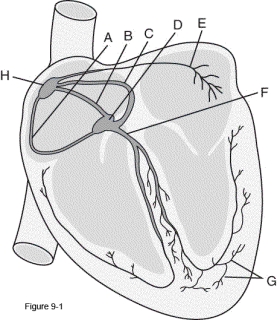
A) A
B) C
C) D
D) H

A) A
B) C
C) D
D) H

Unlock Deck
Unlock for access to all 77 flashcards in this deck.
Unlock Deck
k this deck
15
Which letter in the figure identifies the anterior internodal pathway?
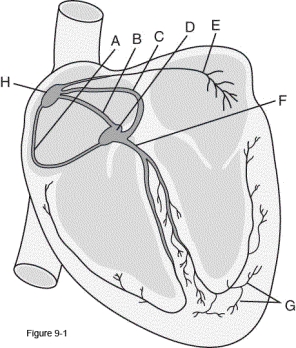
A) A
B) C
C) E
D) F

A) A
B) C
C) E
D) F

Unlock Deck
Unlock for access to all 77 flashcards in this deck.
Unlock Deck
k this deck
16
Which letter in the figure identifies the cardiac cells through which there is a 100-ms delay?
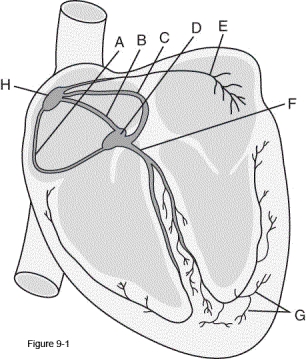
A) A
B) B
C) C
D) D

A) A
B) B
C) C
D) D

Unlock Deck
Unlock for access to all 77 flashcards in this deck.
Unlock Deck
k this deck
17
The ability of certain specialized cells of the heart to depolarize spontaneously is known as which of the following?
A) Diastasis
B) Excitability
C) Automaticity
D) Conductivity
A) Diastasis
B) Excitability
C) Automaticity
D) Conductivity

Unlock Deck
Unlock for access to all 77 flashcards in this deck.
Unlock Deck
k this deck
18
How many millimeters are between each heavy vertical line on electrocardiographic paper?
A) 1.0
B) 2.0
C) 4.0
D) 5.0
A) 1.0
B) 2.0
C) 4.0
D) 5.0

Unlock Deck
Unlock for access to all 77 flashcards in this deck.
Unlock Deck
k this deck
19
The QRS vector appears downward in which of the following electrocardiogram leads?
A) II
B) V5
C) aVL
D) aVR
A) II
B) V5
C) aVL
D) aVR

Unlock Deck
Unlock for access to all 77 flashcards in this deck.
Unlock Deck
k this deck
20
Electrical stimulation of a cardiac muscle cell is the definition of which of the following?
A) Contraction
B) Refraction
C) Polarization
D) Depolarization
A) Contraction
B) Refraction
C) Polarization
D) Depolarization

Unlock Deck
Unlock for access to all 77 flashcards in this deck.
Unlock Deck
k this deck
21
Which of the following might cause sinus tachycardia?
A) Vomiting
B) Hypothermia
C) Thyrotoxicosis
D) Mediastinal tumors
A) Vomiting
B) Hypothermia
C) Thyrotoxicosis
D) Mediastinal tumors

Unlock Deck
Unlock for access to all 77 flashcards in this deck.
Unlock Deck
k this deck
22
What is the cardiac rhythm depicted on the following electrocardiogram?

A) Atrial fibrillation
B) Premature atrial beats
C) Paroxysmal atrial tachycardia
D) Premature ventricular contractions

A) Atrial fibrillation
B) Premature atrial beats
C) Paroxysmal atrial tachycardia
D) Premature ventricular contractions

Unlock Deck
Unlock for access to all 77 flashcards in this deck.
Unlock Deck
k this deck
23
Isovolumetric contraction of the ventricles follows which electrocardiographic event?
A) P wave
B) R wave
C) S wave
D) T wave
A) P wave
B) R wave
C) S wave
D) T wave

Unlock Deck
Unlock for access to all 77 flashcards in this deck.
Unlock Deck
k this deck
24
What are the atrial and ventricular rates for lead I in the following electrocardiogram?
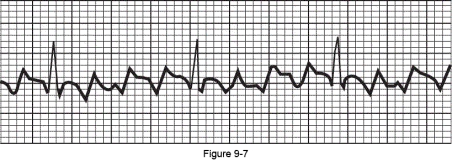
Atrial Rate Ventricular Rate
A) 75 225
B) 180 90
C) 300 75
D) 135 45

Atrial Rate Ventricular Rate
A) 75 225
B) 180 90
C) 300 75
D) 135 45

Unlock Deck
Unlock for access to all 77 flashcards in this deck.
Unlock Deck
k this deck
25
Which of the following is the most characteristic electrocardiographic finding in myocardial infarction?
A) T wave inversion
B) ST segment elevation
C) ST segment depression
D) Downward-deflected Q waves
A) T wave inversion
B) ST segment elevation
C) ST segment depression
D) Downward-deflected Q waves

Unlock Deck
Unlock for access to all 77 flashcards in this deck.
Unlock Deck
k this deck
26
The heart block that causes "dropped" beats and that is often the result of increased parasympathetic tone is called _____ block.
A) Sinoatrial
B) Mobitz type I
C) First-degree atrioventricular
D) Left bundle branch
A) Sinoatrial
B) Mobitz type I
C) First-degree atrioventricular
D) Left bundle branch

Unlock Deck
Unlock for access to all 77 flashcards in this deck.
Unlock Deck
k this deck
27
The aVL lead shows the electrocardiogram in the below figure.This is indicative of the occlusion of which of the following coronary arteries?
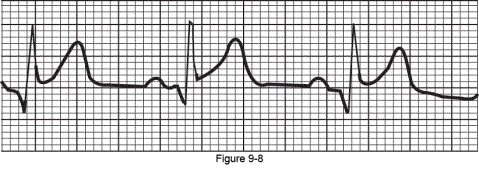
A) Left coronary artery
B) Circumflex artery
C) Right coronary artery
D) Anterior interventricular branch of the left coronary artery

A) Left coronary artery
B) Circumflex artery
C) Right coronary artery
D) Anterior interventricular branch of the left coronary artery

Unlock Deck
Unlock for access to all 77 flashcards in this deck.
Unlock Deck
k this deck
28
On an electrocardiogram,which of the following represents ventricular depolarization and repolarization?
A) P-R interval
B) Q-T interval
C) ST segment
D) QRS complex
A) P-R interval
B) Q-T interval
C) ST segment
D) QRS complex

Unlock Deck
Unlock for access to all 77 flashcards in this deck.
Unlock Deck
k this deck
29
On an electrocardiogram,which of the following represents ventricular repolarization?
A) T wave
B) P-R interval
C) ST segment
D) QRS complex
A) T wave
B) P-R interval
C) ST segment
D) QRS complex

Unlock Deck
Unlock for access to all 77 flashcards in this deck.
Unlock Deck
k this deck
30
Ingestion of large quantities of coffee may cause which of the following?
A) Sinus bradycardia
B) Junctional rhythms
C) Bundle branch blocks
D) Premature ventricular beats
A) Sinus bradycardia
B) Junctional rhythms
C) Bundle branch blocks
D) Premature ventricular beats

Unlock Deck
Unlock for access to all 77 flashcards in this deck.
Unlock Deck
k this deck
31
What is the heart rate shown on the following ECG?

A) 60
B) 78
C) 90
D) 100

A) 60
B) 78
C) 90
D) 100

Unlock Deck
Unlock for access to all 77 flashcards in this deck.
Unlock Deck
k this deck
32
Pressure rising in the ventricles but no blood being ejected is the definition of:
A) ventricular systole.
B) ventricular diastole.
C) isovolumetric relaxation.
D) isovolumetric contraction.
A) ventricular systole.
B) ventricular diastole.
C) isovolumetric relaxation.
D) isovolumetric contraction.

Unlock Deck
Unlock for access to all 77 flashcards in this deck.
Unlock Deck
k this deck
33
Repolarization of the papillary muscles or remnants of ventricular repolarization appears on an electrocardiogram as a:
A) P wave.
B) T wave.
C) U wave.
D) J point.
A) P wave.
B) T wave.
C) U wave.
D) J point.

Unlock Deck
Unlock for access to all 77 flashcards in this deck.
Unlock Deck
k this deck
34
The right ventricle peak systolic pressure is represented by _____ millimeters of mercury.
A) 15
B) 25
C) 80
D) 120
A) 15
B) 25
C) 80
D) 120

Unlock Deck
Unlock for access to all 77 flashcards in this deck.
Unlock Deck
k this deck
35
What is the name of the following cardiac arrhythmia?
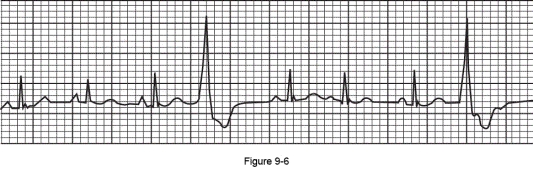
A) Paroxysmal atrial tachycardia
B) Atrial premature depolarization
C) Premature ventricular contractions
D) Wolff-Parkinson-White syndrome

A) Paroxysmal atrial tachycardia
B) Atrial premature depolarization
C) Premature ventricular contractions
D) Wolff-Parkinson-White syndrome

Unlock Deck
Unlock for access to all 77 flashcards in this deck.
Unlock Deck
k this deck
36
A prolonged R-R interval indicates which of the following kinds of cardiac arrhythmia?
A) Atrial fibrillation
B) Sinoatrial block
C) Premature ventricular beats
D) Paroxysmal atrial tachycardia
A) Atrial fibrillation
B) Sinoatrial block
C) Premature ventricular beats
D) Paroxysmal atrial tachycardia

Unlock Deck
Unlock for access to all 77 flashcards in this deck.
Unlock Deck
k this deck
37
b-Adrenergic blocking agents,such as propranolol,can cause:
A) sinoatrial block.
B) sinus tachycardia.
C) sinus bradycardia.
D) premature atrial beats.
A) sinoatrial block.
B) sinus tachycardia.
C) sinus bradycardia.
D) premature atrial beats.

Unlock Deck
Unlock for access to all 77 flashcards in this deck.
Unlock Deck
k this deck
38
What is the heart rate depicted on the following electrocardiogram?

A) 60
B) 80
C) 100
D) 120

A) 60
B) 80
C) 100
D) 120

Unlock Deck
Unlock for access to all 77 flashcards in this deck.
Unlock Deck
k this deck
39
What is the heart rate shown on the following electrocardiogram?

A) 150
B) 200
C) 250
D) 300

A) 150
B) 200
C) 250
D) 300

Unlock Deck
Unlock for access to all 77 flashcards in this deck.
Unlock Deck
k this deck
40
During diastasis,which of the following occurs within the ventricles?
A) Pressure increases.
B) Blood enters slowly.
C) Pressure falls dramatically.
D) Blood pushes against the semilunar valves.
A) Pressure increases.
B) Blood enters slowly.
C) Pressure falls dramatically.
D) Blood pushes against the semilunar valves.

Unlock Deck
Unlock for access to all 77 flashcards in this deck.
Unlock Deck
k this deck
41
Which of the following lumens will not appear on a cross-sectional view of a triple-lumen pulmonary artery catheter at 20 cm back from the tip?
A) Distal
B) Inflation
C) Proximal
D) Thermistor
A) Distal
B) Inflation
C) Proximal
D) Thermistor

Unlock Deck
Unlock for access to all 77 flashcards in this deck.
Unlock Deck
k this deck
42
Falsely elevated systolic and diastolic blood pressure readings can occur when using either a manual or an automatic system because of which of the following?
A) Improper positioning
B) Motion artifacts
C) Undersized cuff
D) Improper inflation
A) Improper positioning
B) Motion artifacts
C) Undersized cuff
D) Improper inflation

Unlock Deck
Unlock for access to all 77 flashcards in this deck.
Unlock Deck
k this deck
43
At what point in the figure do the semilunar valves close?
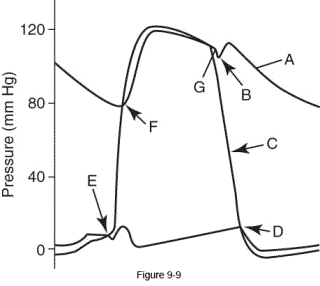
A) A
B) B
C) C
D) D

A) A
B) B
C) C
D) D

Unlock Deck
Unlock for access to all 77 flashcards in this deck.
Unlock Deck
k this deck
44
The cuff of a sphygmomanometer should be inflated to _____ mm Hg above the point when the radial pulse disappears.
A) 10
B) 20
C) 30
D) 40
A) 10
B) 20
C) 30
D) 40

Unlock Deck
Unlock for access to all 77 flashcards in this deck.
Unlock Deck
k this deck
45
At what point in the figure do the atrioventricular valves close?

A) B
B) D
C) E
D) F

A) B
B) D
C) E
D) F

Unlock Deck
Unlock for access to all 77 flashcards in this deck.
Unlock Deck
k this deck
46
The right heart catheterization waveform in the figure that represents pressure in the right ventricle is which of the following?

A) A
B) B
C) C
D) D

A) A
B) B
C) C
D) D

Unlock Deck
Unlock for access to all 77 flashcards in this deck.
Unlock Deck
k this deck
47
On an atrial pressure tracing,which wave corresponds to atrial diastole?
A) a wave
B) c wave
C) R wave
D) P wave
A) a wave
B) c wave
C) R wave
D) P wave

Unlock Deck
Unlock for access to all 77 flashcards in this deck.
Unlock Deck
k this deck
48
The thermistor is located ____ cm back from the tip of a pulmonary artery catheter.
A) 2
B) 10
C) 30
D) 50
A) 2
B) 10
C) 30
D) 50

Unlock Deck
Unlock for access to all 77 flashcards in this deck.
Unlock Deck
k this deck
49
Which port on a Swan-Ganz catheter is used to measure cardiac output?
A) Distal
B) Inflation
C) Proximal
D) Thermistor
A) Distal
B) Inflation
C) Proximal
D) Thermistor

Unlock Deck
Unlock for access to all 77 flashcards in this deck.
Unlock Deck
k this deck
50
The first sound heard,by stethoscope,when deflating a sphygmomanometer cuff is known as which of the following?
A) Atrial systole
B) Systolic pressure
C) First heart sound
D) Diastolic pressure
A) Atrial systole
B) Systolic pressure
C) First heart sound
D) Diastolic pressure

Unlock Deck
Unlock for access to all 77 flashcards in this deck.
Unlock Deck
k this deck
51
The proximal opening on a pulmonary artery catheter is used to measure:
A) cardiac output.
B) central venous pressure.
C) pulmonary artery pressure.
D) pulmonary capillary wedge pressure.
A) cardiac output.
B) central venous pressure.
C) pulmonary artery pressure.
D) pulmonary capillary wedge pressure.

Unlock Deck
Unlock for access to all 77 flashcards in this deck.
Unlock Deck
k this deck
52
A phonocardiogram is used to detect which of the following heart sounds?
A) S1 and S2
B) S2 and S3
C) S3 and S4
D) S1 and S4
A) S1 and S2
B) S2 and S3
C) S3 and S4
D) S1 and S4

Unlock Deck
Unlock for access to all 77 flashcards in this deck.
Unlock Deck
k this deck
53
A pulmonary artery catheter introduced via the antecubital route is currently at the 50-cm mark and is showing the tracing below.Is there a problem with this catheter?
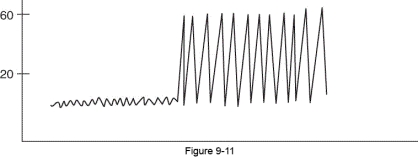
A) Yes; the balloon has ruptured.
B) No; it's in the pulmonary artery.
C) Yes; it's knotted in the right ventricle.
D) No; it's wedged in a pulmonary capillary.

A) Yes; the balloon has ruptured.
B) No; it's in the pulmonary artery.
C) Yes; it's knotted in the right ventricle.
D) No; it's wedged in a pulmonary capillary.

Unlock Deck
Unlock for access to all 77 flashcards in this deck.
Unlock Deck
k this deck
54
Closure of the semilunar valves and opening of the atrioventricular valves is associated with which heart sound?
A) S1
B) S2
C) S3
D) S4
A) S1
B) S2
C) S3
D) S4

Unlock Deck
Unlock for access to all 77 flashcards in this deck.
Unlock Deck
k this deck
55
The atrial kick becomes important to ventricular filling during which of the following?
A) Atrial flutter
B) Atrial fibrillation
C) Ventricular asystole
D) Ventricular tachycardia
A) Atrial flutter
B) Atrial fibrillation
C) Ventricular asystole
D) Ventricular tachycardia

Unlock Deck
Unlock for access to all 77 flashcards in this deck.
Unlock Deck
k this deck
56
Other than air,the gas that is commonly used to inflate the balloon on a pulmonary artery catheter is:
A) helium.
B) nitrogen.
C) oxygen.
D) carbon dioxide.
A) helium.
B) nitrogen.
C) oxygen.
D) carbon dioxide.

Unlock Deck
Unlock for access to all 77 flashcards in this deck.
Unlock Deck
k this deck
57
Pulmonary artery occlusion pressure can be used to estimate:
A) left-atrial preload.
B) left-atrial afterload.
C) left-ventricular end-diastolic pressure.
D) right-ventricular end-diastolic pressure.
A) left-atrial preload.
B) left-atrial afterload.
C) left-ventricular end-diastolic pressure.
D) right-ventricular end-diastolic pressure.

Unlock Deck
Unlock for access to all 77 flashcards in this deck.
Unlock Deck
k this deck
58
The a wave on an arterial pressure tracing is a result of which of the following during a cardiac cycle?
A) Atrial systole
B) Atrial diastole
C) Ventricular systole
D) Ventricular diastole
A) Atrial systole
B) Atrial diastole
C) Ventricular systole
D) Ventricular diastole

Unlock Deck
Unlock for access to all 77 flashcards in this deck.
Unlock Deck
k this deck
59
Which of the following is true concerning junctional rhythms?
A) They produce no P waves.
B) They can produce inverted P waves.
C) They are only generated high in the atrioventricular node.
D) Their rates can vary from 60 beats/min to 80 beats/min.
A) They produce no P waves.
B) They can produce inverted P waves.
C) They are only generated high in the atrioventricular node.
D) Their rates can vary from 60 beats/min to 80 beats/min.

Unlock Deck
Unlock for access to all 77 flashcards in this deck.
Unlock Deck
k this deck
60
When does the atrial kick begin?
A) Just before atrial systole
B) During atrial repolarization
C) During the impulse delay in the atrioventricular node
D) Simultaneously with ventricular excitation
A) Just before atrial systole
B) During atrial repolarization
C) During the impulse delay in the atrioventricular node
D) Simultaneously with ventricular excitation

Unlock Deck
Unlock for access to all 77 flashcards in this deck.
Unlock Deck
k this deck
61
Systemic vascular resistance is 1700 dynes cm⁻⁵.Which of the following is consistent with this value?
A) Elevated left-ventricular afterload
B) Elevated right-ventricular afterload
C) Decreased left-ventricular preload
D) Decreased right-ventricular preload
A) Elevated left-ventricular afterload
B) Elevated right-ventricular afterload
C) Decreased left-ventricular preload
D) Decreased right-ventricular preload

Unlock Deck
Unlock for access to all 77 flashcards in this deck.
Unlock Deck
k this deck
62
Which of the following is defined as the resistance that a ventricle must overcome to eject blood?
A) Stroke work
B) Stroke index
C) Ventricular preload
D) Ventricular afterload
A) Stroke work
B) Stroke index
C) Ventricular preload
D) Ventricular afterload

Unlock Deck
Unlock for access to all 77 flashcards in this deck.
Unlock Deck
k this deck
63
How long are adult pulmonary artery catheters?
A) 60 cm
B) 80 cm
C) 100 cm
D) 110 cm
A) 60 cm
B) 80 cm
C) 100 cm
D) 110 cm

Unlock Deck
Unlock for access to all 77 flashcards in this deck.
Unlock Deck
k this deck
64
Which of the following lumens found in a standard balloon floatation catheter would be used to obtain a mixed venous blood sample?
A) Balloon lumen
B) Distal lumen
C) Proximal lumen
D) Thermodilution lumen
A) Balloon lumen
B) Distal lumen
C) Proximal lumen
D) Thermodilution lumen

Unlock Deck
Unlock for access to all 77 flashcards in this deck.
Unlock Deck
k this deck
65
Which of the following is a type of pressure transducer that uses a metal bellows and a Wheatstone bridge?
A) Resistive (or resistance)
B) Strain gauge
C) Variable inductance
D) Variable capacitance
A) Resistive (or resistance)
B) Strain gauge
C) Variable inductance
D) Variable capacitance

Unlock Deck
Unlock for access to all 77 flashcards in this deck.
Unlock Deck
k this deck
66
Which of the following represents the port on a pulmonary artery catheter used to take measurements that estimate right-ventricular end-diastolic pressure?
A) Distal
B) Balloon
C) Proximal
D) Thermistor
A) Distal
B) Balloon
C) Proximal
D) Thermistor

Unlock Deck
Unlock for access to all 77 flashcards in this deck.
Unlock Deck
k this deck
67
The display from the proximal port of a pulmonary artery catheter reads 12 cm H₂O.This measurement is which of the following?
A) Stroke work index
B) Central venous pressure
C) Pulmonary artery pressure
D) Pulmonary capillary wedge pressure
A) Stroke work index
B) Central venous pressure
C) Pulmonary artery pressure
D) Pulmonary capillary wedge pressure

Unlock Deck
Unlock for access to all 77 flashcards in this deck.
Unlock Deck
k this deck
68
What is the cardiac index (CI)when cardiac output = 5.0 mL/min and body surface area (BSA)= 2.9 m²?
A) 1.72 L/min/m2
B) 1.67 L/min/m2
C) 2.10 L/min/m2
D) 12.5 L/min/m2
A) 1.72 L/min/m2
B) 1.67 L/min/m2
C) 2.10 L/min/m2
D) 12.5 L/min/m2

Unlock Deck
Unlock for access to all 77 flashcards in this deck.
Unlock Deck
k this deck
69
Rupture of the pulmonary artery catheter balloon can cause which of the following?
A) Atrial flutter
B) Air embolism
C) Pneumothorax
D) Pulmonary infarction
A) Atrial flutter
B) Air embolism
C) Pneumothorax
D) Pulmonary infarction

Unlock Deck
Unlock for access to all 77 flashcards in this deck.
Unlock Deck
k this deck
70
What is the cardiac output,by using the direct Fick method,for a patient with the following hemodynamic values?
A) 3.5 mL/min
B) 4.36 mL/min
C) 5.83 mL/min
D) 6.15 mL/min
A) 3.5 mL/min
B) 4.36 mL/min
C) 5.83 mL/min
D) 6.15 mL/min

Unlock Deck
Unlock for access to all 77 flashcards in this deck.
Unlock Deck
k this deck
71
What is the cardiac output when oxygen (O₂)consumption = 200 mL/min,arterial O₂ content = 21 vol%,and mixed venous O₂ content = 15 vol%?
A) 3.3 mL/min
B) 4.3 mL/min
C) 5.3 mL/min
D) 6.3 mL/min
A) 3.3 mL/min
B) 4.3 mL/min
C) 5.3 mL/min
D) 6.3 mL/min

Unlock Deck
Unlock for access to all 77 flashcards in this deck.
Unlock Deck
k this deck
72
Which of the following events can lead to ventricular fibrillation?
A) A ventricular rate of ninety beats a minute
B) A premature ventricular beat that occurs during the T wave
C) The presence of saw tooth waves instead of P waves on an electrocardiogram
D) An increased width of the QRS complex
A) A ventricular rate of ninety beats a minute
B) A premature ventricular beat that occurs during the T wave
C) The presence of saw tooth waves instead of P waves on an electrocardiogram
D) An increased width of the QRS complex

Unlock Deck
Unlock for access to all 77 flashcards in this deck.
Unlock Deck
k this deck
73
Which of the following formulas represents cardiac output (CO)?
A) CO = cardiac index * body surface area
B) CO = stroke volume * body surface area
C) CO = heart rate * stroke volume
D) CO = oxygen consumption * (CAO₂ - CaO₂)
A) CO = cardiac index * body surface area
B) CO = stroke volume * body surface area
C) CO = heart rate * stroke volume
D) CO = oxygen consumption * (CAO₂ - CaO₂)

Unlock Deck
Unlock for access to all 77 flashcards in this deck.
Unlock Deck
k this deck
74
Which of the following can increase pulmonary vascular resistance?
A) Alveolar hypoxia
B) Moderate hypoxemia
C) Decreased parasympathetic tone
D) Recruitment of pulmonary vessels
A) Alveolar hypoxia
B) Moderate hypoxemia
C) Decreased parasympathetic tone
D) Recruitment of pulmonary vessels

Unlock Deck
Unlock for access to all 77 flashcards in this deck.
Unlock Deck
k this deck
75
Right-ventricular afterload can be estimated by using which equation?
A) (MAP) * (SV) * (0.00136)
B) (MPAP) * (SV) * (0.00136)
C) (MAP - MRAP/CO) * 80
D) (MPAP - MLAP/CO) * 80
A) (MAP) * (SV) * (0.00136)
B) (MPAP) * (SV) * (0.00136)
C) (MAP - MRAP/CO) * 80
D) (MPAP - MLAP/CO) * 80

Unlock Deck
Unlock for access to all 77 flashcards in this deck.
Unlock Deck
k this deck
76
What is the cardiac output when O₂ consumption = 180 mL/min,arterial O₂ content = 18.4 vol%,and mixed venous O₂ content = 14.4 vol%.
A) 4.5 mL/min
B) 5.5 mL/min
C) 6.5 mL/min
D) 7.5 mL/min
A) 4.5 mL/min
B) 5.5 mL/min
C) 6.5 mL/min
D) 7.5 mL/min

Unlock Deck
Unlock for access to all 77 flashcards in this deck.
Unlock Deck
k this deck
77
Which of the following will cause an increase in systemic vascular resistance?
A) Hydralazine
B) Nitroglycerin
C) Polycythemia
D) Moderate hypoxemia
A) Hydralazine
B) Nitroglycerin
C) Polycythemia
D) Moderate hypoxemia

Unlock Deck
Unlock for access to all 77 flashcards in this deck.
Unlock Deck
k this deck



